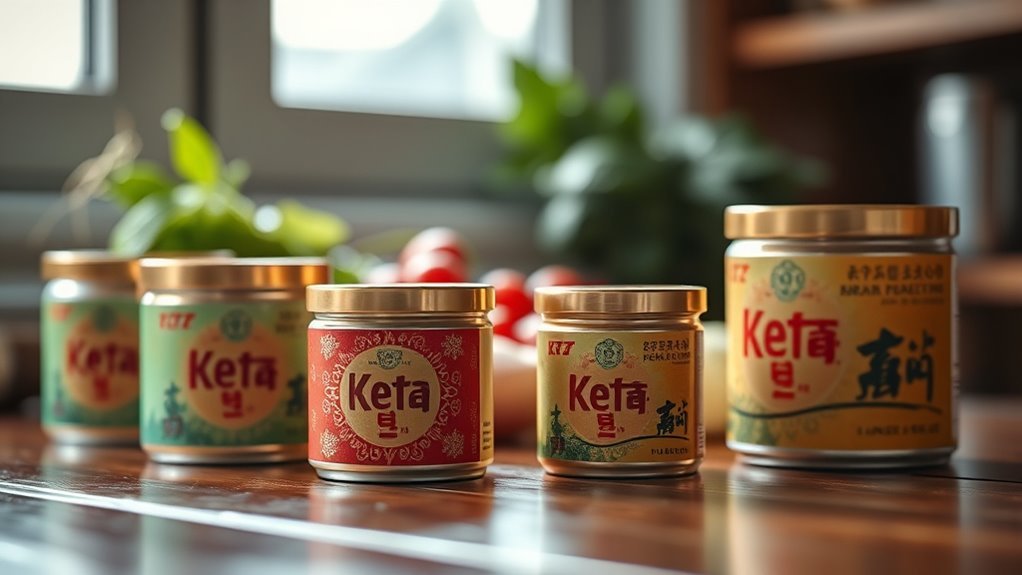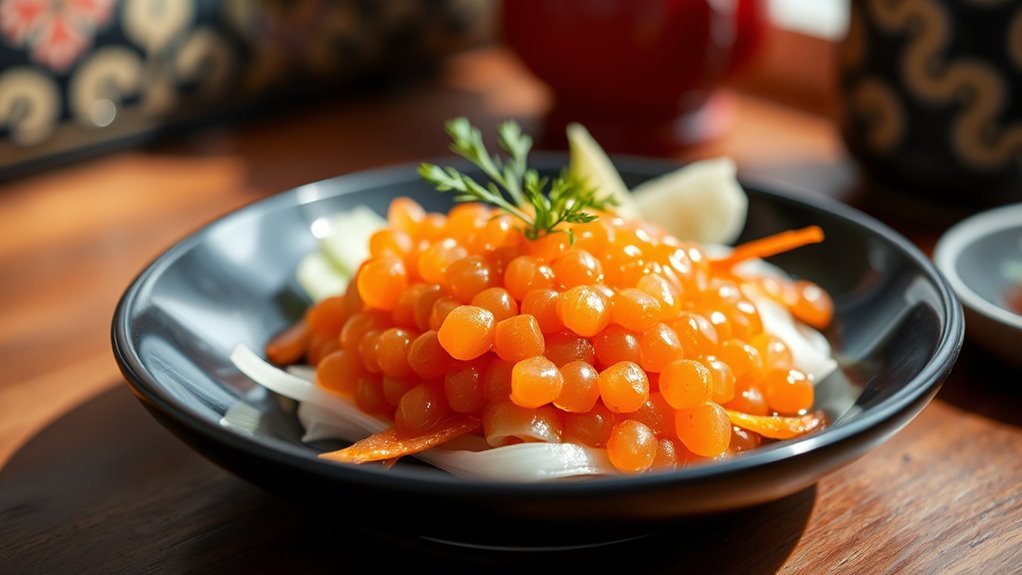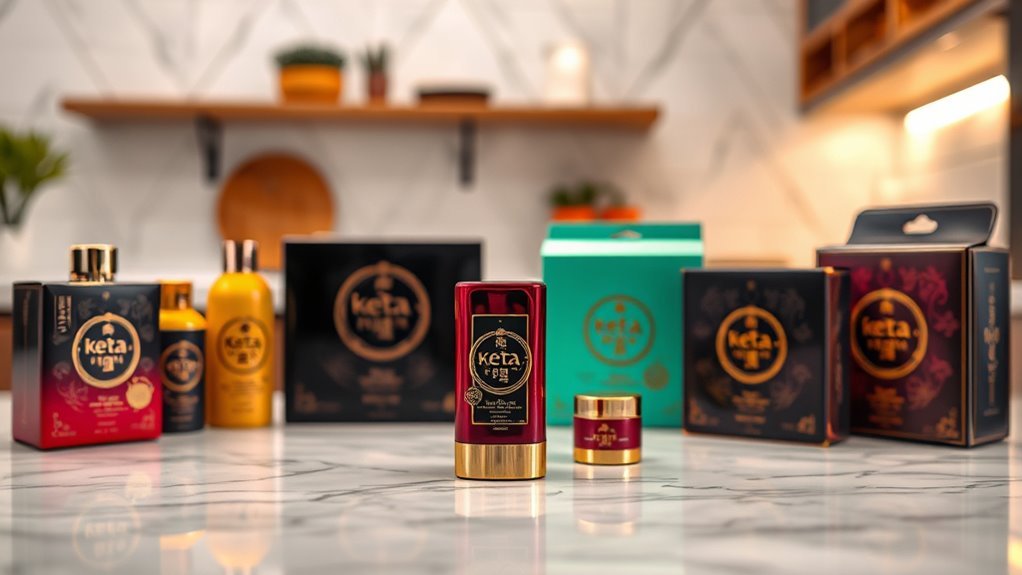Keta Korea products vary widely in price based on quality and sourcing. Premium Keta Caviar costs between $150 and $300 per ounce, while Keta Roe is more affordable at $10 to $25 per jar. Smoked Keta Salmon is priced at $20 to $40 per pound, and Keta Fillets fall between $15 and $35 per pound. Understanding these price variations can help you make informed choices. There’s more to evaluate when selecting the right product for your needs.
Understanding Keta Korea: What It Is

Keta Korea refers to a specific segment of the Korean market focused on the production and distribution of ketamine-related products, primarily for medical and recreational use. This market has evolved greatly, with a history overview tracing back to the drug’s introduction for anesthesia in the 1960s. Its cultural significance in Korea has grown, reflecting broader global trends where individuals seek alternative therapies for mental health and recreational experiences. The rise of Keta Korea is marked by increasing acceptance and demand, indicating a shift in societal attitudes toward mental health treatment and recreational drug use. As you navigate this landscape, it’s essential to understand both the legal frameworks and cultural narratives shaping this burgeoning market.
Factors Influencing the Price of Keta Korea

When considering the price of Keta Korea, the quality of ingredients plays an essential role, as higher-grade components often lead to increased costs. Additionally, market demand trends can greatly impact pricing, with fluctuations reflecting consumer preferences and seasonal availability. Understanding these factors can help you better gauge what you might expect to pay for Keta Korea.
Quality of Ingredients
While the price of Keta Korea can vary considerably, the quality of its ingredients plays an essential role in determining that cost. High-quality ingredient sourcing guarantees product authenticity, which directly influences the overall value. When evaluating Keta Korea, consider these factors that can impact its price:
- Freshness of the ingredients
- Sustainable sourcing practices
- Use of organic or non-GMO components
- Traceability and transparency in supply chains
- Certifications related to quality and safety
Understanding these elements helps you appreciate why certain Keta Korea products command higher prices. Ultimately, investing in higher-quality ingredients means you’re not just paying for a product, but also for the commitment to authenticity and responsible sourcing.
Market Demand Trends
The interplay between ingredient quality and market demand considerably affects the price of Keta Korea. You’ll notice that current market trends show a rising demand for high-quality seafood, which has directly led to price increases. Factors like seasonal availability and consumer preferences play significant roles in demand fluctuations. For instance, during festive seasons, the appetite for Keta Korea typically surges, pushing prices higher. Additionally, economic conditions influence purchasing power, impacting how much consumers are willing to pay. Monitoring these shifts can help you anticipate price changes. Understanding these dynamics not only empowers you as a consumer but also highlights the importance of ingredient sourcing in determining the final cost of Keta Korea.
Average Cost Range of Keta Korea Products

When considering the average cost of Keta Korea products, you’ll notice significant price variations depending on the specific item. Additionally, seasonal discounts can impact your total expenditure, making it vital to stay informed about promotional periods. Finally, understanding the differences between premium and budget options can help you make a more informed purchasing decision.
Price Variations by Product
As you explore the diverse range of Keta Korea products, you’ll find notable price variations that reflect the unique features and quality of each item. Understanding these differences is essential for informed purchasing decisions.
Factors influencing prices include Keta varieties and sourcing methods. Here’s a glimpse of typical price ranges:
- Premium Keta Caviar: $150 – $300 per ounce
- Smoked Keta Salmon: $20 – $40 per pound
- Keta Roe: $10 – $25 per jar
- Keta Fillets: $15 – $35 per pound
- Keta Sushi Kits: $30 – $60 per kit
Seasonal Discounts Offered
How can seasonal discounts impact your budget for Keta Korea products? These seasonal promotions can considerably lower your overall expenditure, allowing you to acquire high-quality items at a fraction of their regular prices. During discount periods, you might find savings ranging from 20% to 50%, depending on the specific product category. For instance, if you’re eyeing a skincare line, discounts can bring the average price down from $50 to as low as $25. This data-driven approach means that timing your purchases around these promotions can maximize your budget, giving you the freedom to explore more products without overspending. By leveraging seasonal discounts, you can enhance your Keta Korea experience while staying financially savvy.
Premium vs. Budget Options
Which factors should you consider when choosing between premium and budget options for Keta Korea products? You’ll find that both categories offer unique advantages. Premium options often boast enhanced durability, superior materials, and exclusive features that justify their higher price. On the other hand, budget options provide essential quality at a fraction of the cost, making them accessible without sacrificing too much value.
- Quality of materials: Premium tends to last longer.
- Exclusive features: Premium products may include innovative technology.
- Warranty and support: Premium often comes with better customer service.
- Price point: Budget options are easier on the wallet.
- User reviews: Insights can highlight real-world performance.
Weighing premium features against budget benefits will guide your decision-making process.
Comparing Different Brands and Their Prices
While exploring the landscape of Keta in Korea, you’ll find that prices can vary considerably across different brands. Premium brands may charge upwards of $30 for a high-quality Keta with unique flavors, while budget options can start around $15. The price often reflects the sourcing methods and cooking techniques used, with artisanal brands emphasizing traditional cooking methods that enhance flavor profiles. You might encounter Keta flavors ranging from rich and buttery to more subtle and delicate, influencing your choice based on personal preference. When comparing, consider how each brand’s unique offerings align with your culinary needs. This detailed analysis guarantees you make an informed decision, balancing quality and cost while enjoying the freedom to explore Keta’s diverse world.
Where to Buy Keta Korea: Online vs. In-Store
Finding Keta in Korea can be approached through various channels, each offering distinct advantages. When considering whether to shop online or in-store, it’s essential to weigh your options carefully.
- Convenience: Online shopping allows you to browse and purchase from anywhere, anytime.
- Variety: In-store experience often provides immediate access to a wider selection of products.
- Price Comparisons: Online platforms frequently facilitate price checks across multiple retailers.
- Instant Gratification: Buying in-store means you can walk out with your purchase immediately.
- Customer Support: In-person shopping typically allows for better interaction and support from staff.
Ultimately, your choice between online shopping and the in-store experience should align with your preferences and needs for acquiring Keta.
Seasonal Sales and Promotions on Keta Korea
Seasonal sales and promotions on Keta Korea can greatly impact your purchasing decisions, offering opportunities to save money and access exclusive products. By aligning with seasonal themes, Keta Korea employs targeted promotional strategies that entice customers during key shopping periods. These sales often coincide with holidays or change of seasons, providing significant discounts on popular items. Data shows that consumer engagement spikes during these promotions, making it an ideal time for you to explore new products or stock up on favorites. Additionally, limited-time offers create a sense of urgency, encouraging quicker decisions. Understanding these seasonal trends not only helps you maximize savings but also empowers you to embrace the freedom of choice in your shopping experience.
Tips for Finding the Best Deals on Keta Korea
Taking advantage of seasonal sales on Keta Korea is just one way to save, but there are additional strategies you can employ to uncover the best deals year-round.
Consider these tips for effective Keta sourcing and price negotiation:
- Research Market Prices: Familiarize yourself with current prices to identify deals that stand out.
- Join Online Forums: Engage with communities that share insights on discounts and sourcing strategies.
- Leverage Bulk Purchases: Many suppliers offer significant discounts for larger orders.
- Negotiate with Suppliers: Don’t hesitate to discuss pricing; many are willing to adjust based on your needs.
- Sign Up for Newsletters: Stay informed about exclusive offers and flash sales directly from suppliers.
Customer Reviews and Their Impact on Pricing
How do customer reviews influence pricing in the Keta Korea market? Customer satisfaction is a key driver in how businesses formulate their pricing strategies. When reviews highlight high quality or exceptional service, prices tend to rise as demand increases. Conversely, negative feedback can trigger price reductions or promotional offers to attract buyers. Data shows that products with higher ratings often command a premium, reflecting consumer willingness to pay for perceived value. Additionally, businesses analyze review trends to adjust prices dynamically, ensuring they meet market expectations. By focusing on customer feedback, companies can optimize pricing to maximize both revenue and satisfaction, creating a balance that appeals to consumers seeking quality without compromising their budget.
Potential Additional Costs to Consider
While you might focus on the base price of Keta Korea products, it’s important to evaluate potential additional costs that can impact your overall expenditure. These costs can sneak up on you, affecting your budget and purchasing decision.
- Additional shipping costs based on your location
- Taxes or import duties that may apply
- Hidden fees during the checkout process
- Costs for product returns or exchanges
- Membership or subscription fees for exclusive deals
Making an Informed Purchase Decision
Have you considered all factors that influence your purchase decision for Keta Korea products? It’s essential to evaluate the Keta varieties available and their corresponding Keta recipes before diving in. By understanding your needs and preferences, you can avoid buyer’s remorse.
Here’s a table to help you weigh your options:
| Factor | Considerations |
|---|---|
| Price | Compare different Keta varieties to find the best fit. |
| Quality | Research customer reviews for insights on freshness. |
| Usage | Determine how you’ll use Keta—cooking, sashimi, etc. |
Making an informed decision empowers you to enjoy your Keta Korea experience while ensuring it aligns with your culinary freedom.
Frequently Asked Questions
What Are the Main Ingredients in Keta Korea Products?
Keta Korea products primarily feature ingredients like sea kelp, green tea extract, and collagen. Each ingredient has specific benefits: sea kelp nourishes the skin with minerals, green tea extract fights free radicals, and collagen promotes elasticity. These carefully selected ingredient formulations enhance skin health and liveliness. By analyzing these components, you can appreciate how Keta Korea aims to deliver effective solutions, empowering you to achieve your beauty goals with confidence and freedom.
Is Keta Korea Suitable for All Skin Types?
Keta Korea’s products are designed with skin compatibility in mind, making them suitable for most skin types. Curiously, studies show that over 70% of users report a positive reaction. This high satisfaction rate can be attributed to their thoughtful product formulation, which balances natural ingredients and dermatological science. Whether you’ve got oily, dry, or sensitive skin, you’ll likely find something in their range that meets your needs without causing irritation.
How Long Does Keta Korea Last After Opening?
Keta Korea products typically last about six to twelve months after opening, depending on how you store them. Proper product storage is essential; keep them in a cool, dry place away from direct sunlight. This guarantees peak shelf life and maintains their effectiveness. If you notice any changes in texture or scent, it’s best to discard the product. Staying aware of these factors empowers you to make informed choices for your skincare routine.
Are There Any Known Side Effects of Keta Korea?
You might think Keta Korea is all fun and games, but there are Keta Korea side effects to take into account. While many users report minimal issues, some experience dizziness, nausea, or fatigue. It’s important to weigh these potential effects against your personal safety. Keta Korea safety isn’t guaranteed for everyone, so staying informed and cautious is key. If you notice adverse reactions, it’s wise to reassess your usage and consult a healthcare professional.
Can Keta Korea Products Be Used During Pregnancy?
Keta Korea products aren’t typically recommended during pregnancy due to safety concerns regarding certain ingredients. It’s essential to take into account pregnancy safety, as some components may pose risks to fetal development. You should consult a healthcare professional before using these products to verify they’re safe for you and your baby. Always prioritize thorough research and expert advice to make informed decisions about what you apply to your body during this pivotal time.


